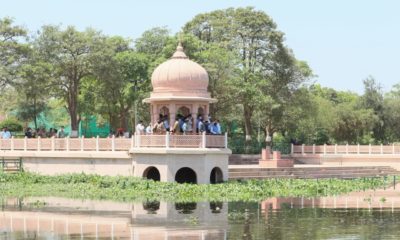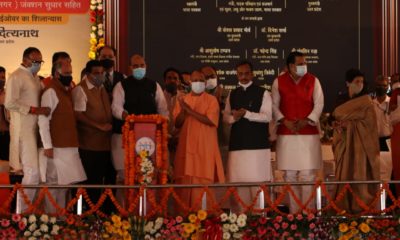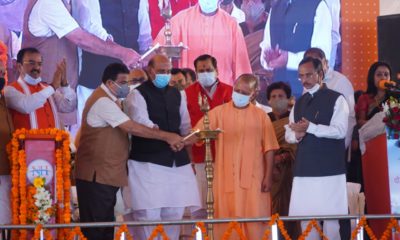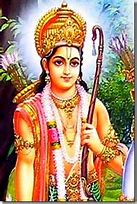Feature
330 years old Shiv temple embellish with chikan pattern in Lucknow

Lucknow: It’s the starting of holy month of sawan and all the shiv temple are crowded with devotees. But here in Lucknow there is a Shiv Temple in Kakori situated outside the city. The most interesting fact about the religious monument is that its design is inspired by chikan motifs.
The intricate design on the pillars of the temple resembles murri (form of stitch) pattern. “The design of the temple, especially floral and ‘keri’ (mango shape) patterns on the wall are exactly like chikan embroidery. The temple was built in 1780 by Raja Tikait Rai, a minister in the royal court of Nawab Asif-Ud-duallah now Protected by ASI (Archeological Survey of India).
The temple is built in an octagonal plan with fluted dome on a slightly raised platform within an enclosure at the sprawling banks of Behta river.
The famous techniques of jaali (net) and murri can also be witnessed on the structure,” said historian Yogesh Praveen. Decorated with stucco technique, the 330-year-old temple was built with lakhauri (old style bricks) and chuna (lime). Urad Dal (pulses), kapaas (cotton), sheera (sugar syrup) and gond (glue) was used to join the lakhauri.
Another interesting fact about the temple is that it never had a priest. There are three caretakers who serve in shifts and are responsible for cleanliness and security on the premises.
“There is something very serene about this place, it is surrounded by wonderful scenic beauty and has a calm river and farms on its sides. Only in the month of Shrawan or on MahaShivratri, locals throng the place, while a fair is organised in the last week of Shrawan,” said Ram Vilas, one of the caretakers.
There is also an arched bridge similar to the temple’s architecture over Behta river. Two Persian marble inscriptions with the date and the name of the builder are visible on one of the pillars.
Superintending archaeologist Indu Prakash said, “This temple and the bridge over Behta river were both built by Raja Tikait Rai in 1786. Both these structures were protected by ASI under monuments of national importance in 1920.”
Entertainment
Meghalaya Reserves Legalized Gambling and Sports Betting for Tourists

The State Scores Extra High on Gaming-Friendly Industry Index
Meghalaya scored 92.85 out of 100 possible points in a Gaming Industry Index and proved to be India’s most gaming-friendly state following its recent profound legislation changes over the field allowing land-based and online gaming, including games of chance, under a licensing regime.
The index by the UK India Business Council (UKIBC) uses a scale of 0 to 100 to measure the level of legalisation on gambling and betting achieved by a state based on the scores over a set of seven different games – lottery, horse racing, betting on sports, poker, rummy, casino and fantasy sports
Starting from February last year, Meghalaya became the third state in India’s northeast to legalise gambling and betting after Sikkim and Nagaland. After consultations with the UKIBC, the state proceeded with the adoption of the Meghalaya Regulation of Gaming Act, 2021 and the nullification of the Meghalaya Prevention of Gambling Act, 1970. Subsequently in December, the Meghalaya Regulation of Gaming Rules, 2021 were notified and came into force.
All for the Tourists
The move to legalise and license various forms of offline and online betting and gambling in Meghalaya is aimed at boosting tourism and creating jobs, and altogether raising taxation revenues for the northeastern state. At the same time, the opportunities to bet and gamble legally will be reserved only for tourists and visitors.
“We came out with a Gaming Act and subsequently framed the Regulation of Gaming Rules, 2021. The government will accordingly issue licenses to operate games of skill and chance, both online and offline,” said James P. K. Sangma, Meghalaya State Law and Taxation Minister speaking in the capital city of Shillong. “But the legalized gambling and gaming will only be for tourists and not residents of Meghalaya,” he continued.
To be allowed to play, tourists and people visiting the state for work or business purposes will have to prove their non-resident status by presenting appropriate documents, in a process similar to a bank KYC (Know Your Customer) procedure.
Meghalaya Reaches Out to a Vast Market
With 140 millions of people in India estimated to bet regularly on sports, and a total of 370 million desi bettors around prominent sporting events, as per data from one of the latest reports by Esse N Videri, Meghalaya is set to reach out and take a piece of a vast market.
Estimates on the financial value of India’s sports betting market, combined across all types of offline channels and online sports and cricket predictions and betting platforms, speak about amounts between $130 and $150 billion (roughly between ₹9.7 and ₹11.5 lakh crore).
Andhra Pradesh, Telangana and Delhi are shown to deliver the highest number of bettors and Meghalaya can count on substantial tourists flow from their betting circles. The sports betting communities of Karnataka, Maharashtra, Uttar Pradesh and Haryana are also not to be underestimated.
Among the sports, cricket is most popular, registering 68 percent of the total bet count analyzed by Esse N Videri. Football takes second position with 11 percent of the bets, followed by betting on FIFA at 7 percent and on eCricket at 5 percent. The last position in the Top 5 of popular sports for betting in India is taken by tennis with 3 percent of the bet count.
Local Citizens will Still have Their Teer Betting
Meghalaya residents will still be permitted to participate in teer betting over arrow-shooting results. Teer is a traditional method of gambling, somewhat similar to a lottery draw, and held under the rules of the Meghalaya Regulation of the Game of Arrow Shooting and the Sale of Teer Tickets Act, 2018.
Teer includes bettors wagering on the number of arrows that reach the target which is placed about 50 meters away from a team of 20 archers positioned in a semicircle.
The archers shoot volleys of arrows at the target for ten minutes, and players place their bets choosing a number between 0 and 99 trying to guess the last two digits of the number of arrows that successfully pierce the target.
If, for example, the number of hits is 256, anyone who has bet on 56 wins an amount eight times bigger than their wager.


























